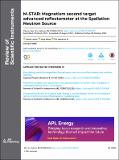| dc.contributor.author | Lauter, Valeria | |
| dc.contributor.author | Wang, Kang | |
| dc.contributor.author | Mewes, Tim | |
| dc.contributor.author | Glavic, Artur | |
| dc.contributor.author | Toperverg, Boris | |
| dc.contributor.author | Ahmadi, Mahshid | |
| dc.contributor.author | Assaf, Badih | |
| dc.contributor.author | Hu, Bin | |
| dc.contributor.author | Li, Mingda | |
| dc.contributor.author | Liu, Xinyu | |
| dc.contributor.author | Liu, Yaohua | |
| dc.contributor.author | Moodera, Jagadeesh | |
| dc.contributor.author | Rokhinson, Leonid | |
| dc.contributor.author | Singh, Deepak | |
| dc.contributor.author | Sun, Nian | |
| dc.date.accessioned | 2023-01-20T18:13:24Z | |
| dc.date.available | 2023-01-20T18:13:24Z | |
| dc.date.issued | 2022 | |
| dc.identifier.uri | https://hdl.handle.net/1721.1/147615 | |
| dc.description.abstract | <jats:p> M-STAR is a next generation polarized neutron reflectometer with advanced capabilities. A new focusing guide concept is optimized for samples with dimensions down to a millimeter range. A proposed hybrid pulse-skipping chopper will enable experiments at constant geometry at one incident angle in a broad range of wavevector transfer Q up to 0.3 A<jats:sup>−1</jats:sup> for specular, off-specular, and GISANS measurements. M-STAR will empower nanoscience and spintronics studies routinely on small samples (∼2 × 2 mm<jats:sup>2</jats:sup>) and of atomic-scale thickness using versatile experimental conditions of magnetic and/or electric fields, light, and temperature applied in situ to novel complex device-like nanosystems with multiple buried interfaces. M-STAR will enable improved grazing incidence diffraction measurements, as a surface-sensitive depth-resolved probe of, e.g., the out-of-plane component of atomic magnetic moments in ferromagnetic, antiferromagnetic, and more complex structures as well as in-plane atomic-scale structures inaccessible with contemporary diffractometry and reflectometry. New horizons will be opened by the development of an option to probe near-surface dynamics with inelastic grazing incidence scattering in the time-of-flight mode. These novel options in combination with ideally matched parameters of the second target station will place M-STAR in the world’s leading position for high resolution polarized reflectometry. </jats:p> | en_US |
| dc.language.iso | en | |
| dc.publisher | AIP Publishing | en_US |
| dc.relation.isversionof | 10.1063/5.0093622 | en_US |
| dc.rights | Creative Commons Attribution 4.0 International license | en_US |
| dc.rights.uri | https://creativecommons.org/licenses/by/4.0/ | en_US |
| dc.source | American Institute of Physics (AIP) | en_US |
| dc.title | M-STAR: Magnetism second target advanced reflectometer at the Spallation Neutron Source | en_US |
| dc.type | Article | en_US |
| dc.identifier.citation | Lauter, Valeria, Wang, Kang, Mewes, Tim, Glavic, Artur, Toperverg, Boris et al. 2022. "M-STAR: Magnetism second target advanced reflectometer at the Spallation Neutron Source." Review of Scientific Instruments, 93 (10). | |
| dc.contributor.department | Massachusetts Institute of Technology. Department of Nuclear Science and Engineering | en_US |
| dc.relation.journal | Review of Scientific Instruments | en_US |
| dc.eprint.version | Final published version | en_US |
| dc.type.uri | http://purl.org/eprint/type/JournalArticle | en_US |
| eprint.status | http://purl.org/eprint/status/PeerReviewed | en_US |
| dc.date.updated | 2023-01-20T18:08:35Z | |
| dspace.orderedauthors | Lauter, V; Wang, K; Mewes, T; Glavic, A; Toperverg, B; Ahmadi, M; Assaf, B; Hu, B; Li, M; Liu, X; Liu, Y; Moodera, J; Rokhinson, L; Singh, D; Sun, N | en_US |
| dspace.date.submission | 2023-01-20T18:08:42Z | |
| mit.journal.volume | 93 | en_US |
| mit.journal.issue | 10 | en_US |
| mit.license | PUBLISHER_CC | |
| mit.metadata.status | Authority Work and Publication Information Needed | en_US |
